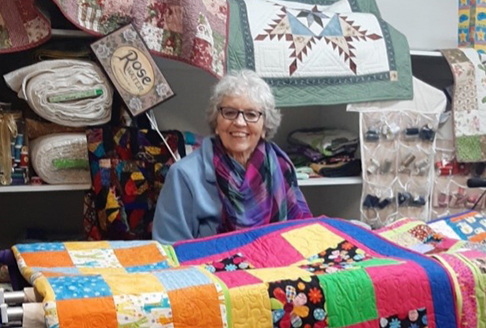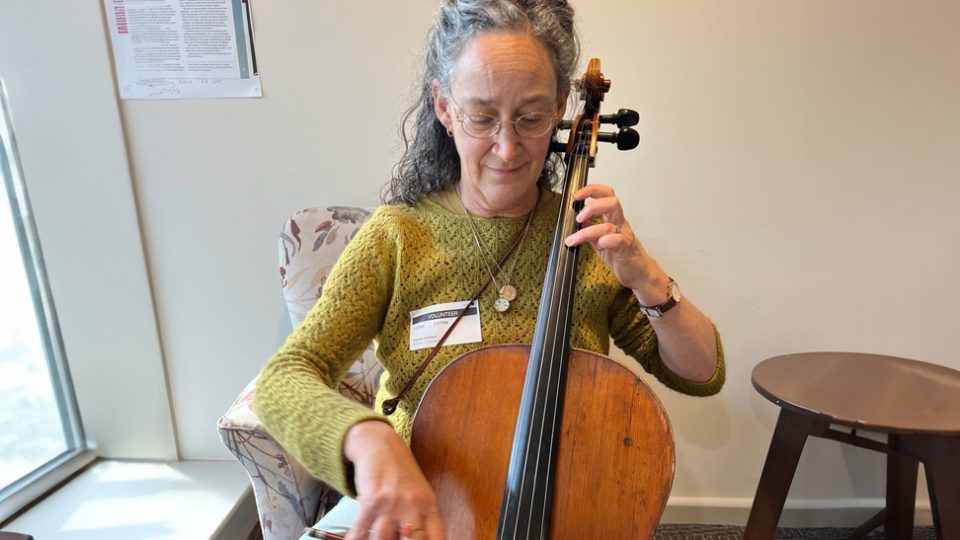The Lady in the Window
– Lyn Spencer's story
- 30 Sep 2021

Lyn Spencer, otherwise known as ‘the lady in the window’, spends hours making quilts in her garage (pictured) that has a large window looking out onto the buzzing streets of her retirement village. “I can quilt and watch the world go by,” she said.
She has been making quilts for over 20 years and thinks she’s probably donated over 3000 quilts during her career, all to people in need. “There’s always need” commented Lyn “and I like giving and sharing things with people”.
Her quilting began when her mother moved into an aged care community, where Lyn made quilts for many of the residents. “I love doing things,” says Lyn. “I can’t sit and do nothing, and I just love fabric. If I can feel fabric every day, I’m happy!”.
The love of crafting is in Lyn’s genes. She remembers cuddling up to bed with her bedridden Nanna after school and helping her make brooches. Lyn has passed the crafty gene down to her grandsons and granddaughters too, all of who have made quilts with Lyn over the years. “It’s wonderful to visit them and see our quilts around their homes.”
Lyn’s donations started in 1986 in response to the Chernobyl disaster. Rotary helped Lyn to send her quilts to over 140 kids in a Ukrainian orphanage. She is now a member of a quilting group called Made with Love made up of about 20 ladies who create quilts for people in need in the community, such as St Kilda Mums, Quilts for Orphans, and more recently Baptcare. Lyn’s quilts are a perfect example of community in action. The materials are mostly donated or sourced by a good friend of Lyn’s from various op shops, and the quilting kits are distributed amongst the members of Made with Love who then contribute different parts of the quilts.
It was Lyn’s sister who led her to Baptcare, after a positive experience with an IHC package and resulted in Lyn’s recent donation of some quilts to the Houses of Hope. Lyn looks forward to a long relationship with Baptcare, sharing her love and quilts wherever they’re needed.
We’re blessed to have Lyn as part of our Baptcare family and so grateful for her loving care and quilts.
Community news
-

Student Volunteer Spotlight - Erin
Did you know that Baptcare has student volunteers at some of our Residential Aged Care communities? Our volunteers are an integral part of our Baptcare community, not only in residential aged care but across many of our programs and services. Volunteers provide essential connection, positivity and assistance to residents, clients and consumers.
- 04 Apr 2025
-

Staff Spotlight: A Day in The Life of a Foster and Kinship Care Practitioner
Rachel Binger is a Foster & Kinship Care Practitioner at Baptcare’s Ulverstone Hub in Tasmania. She starts the day with penguins, ends it with bingeable television, and in between supports everyday superheroes: foster carers.
- 02 Apr 2025
-

Volunteer Spotlight: Louise Godwin and her cello
Our Baptcare volunteers are amazing and it is always wonderful to have the chance to get to know them and learn a little about why they volunteer with Baptcare. Louise, a relatively new volunteer at Baptcare Karana Residential Aged Care community, tells us all about her musical talents and why she volunteers her time twice a week to play cello for the residents.
- 01 Apr 2025
